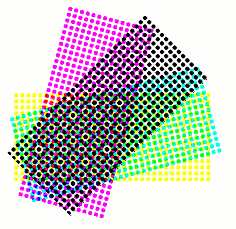 |
Colour separations
This page sets out to answer the question: how are colour images
screened?
There are a number of colour specification systems around, but they all
share the property that a colour is specified with reference to some
number of orthogonal axes. The colour system most people are familiar
with is RGB, where there are three axes, one for the red, green and
blue channels. The RGB system is additive - the red, green and
blue components add together to give the final colour - but not all
colour systems are additive. In particular, the CMYK (cyan, magenta,
yellow and black) colour system is subtractive. In these kinds
of colour systems, mixing the pigments causes a smaller set of
wavelength to be reflected, narrowing down the colour until it reaches
the one specified.
CMY is the complement of RGB. That is:
- C = 1 - R
- M = 1 - G
- Y = 1 - B
The black component can be varied from 0 to min(C, M, Y). Most
pre-press software will allow the user to specify the percentage
P of black to be pulled out. To take account of P then:
- K = P * min(C, M, Y)
- C = C - K
- M = M - K
- Y = Y - K
By pulling black out the amount of ink on the page can be limited.
For example, consider printing a black area with no black pullout: C,
M, and Y would all be 1, giving 300% ink on the paper. This means the
ink takes longer to dry, and it can lead to bleeding if the paper is
too absorbent. If all the black was pulled out, then C = M = Y = 0,
and K = 1. The ink coverage would then be down to 100%. In general,
the amount of ink on the page should be controlled to between 100% and
200%.
The techniques used to screen greyscale images can be extended to
colour spaces with orthogonal axes. Each colour channel is screened
separately from all the others, then they are recombined to get the
final picture. Often, this recombination stage is done at the
printers, when all the inks meet the paper. Until then, the channels
are kept on separate films - hence the term colour separation.
In order to reduce the amount of overprinting of inks, the different
colours are screened with different angles. While in principle any
angles can be used, the choice is limited by the need to reduce
unsightly moiré as far as possible. The normally used angles are
shown in Figure 1 below.
 Fig 1: CMYK angles
The cyan channel is at 15°, magenta at 75°, yellow at 0°,
and black at 45°. Notice how little rings, known as
rosettes are formed once all 4 channels are present. The
rosettes in Figure 1 are closed - their centers are filled in.
Closed rosettes are easier to generate, but make the registration of
the colours at the final printing stage much harder, since any slight
error shows up. Open rosettes can be achived by offseting one of the
channels by half a cell width.
As a demonstration of the difference between separating to RGB
colourspace, and separating to CMYK, consider Figure 2:
Fig 1: CMYK angles
The cyan channel is at 15°, magenta at 75°, yellow at 0°,
and black at 45°. Notice how little rings, known as
rosettes are formed once all 4 channels are present. The
rosettes in Figure 1 are closed - their centers are filled in.
Closed rosettes are easier to generate, but make the registration of
the colours at the final printing stage much harder, since any slight
error shows up. Open rosettes can be achived by offseting one of the
channels by half a cell width.
As a demonstration of the difference between separating to RGB
colourspace, and separating to CMYK, consider Figure 2:
 (a) original picture
(a) original picture
 |
 |
| (b) RGB |
(c) CMYK |
Fig 2: effect of colourspace
The CMYK version had 100% of the black pulled out; both versions used
a cell size of 4 pixels (with a factor of 3 times oversampling), and
the Euclidean spot function. As you can see, the CMYK version has a
more complex rosette-based pattern, and as a result the screen angles
are less noticable. Both images were Gaussian blurred (RLE) by 1
pixel to simulate inks mixing on paper.
[ Back to index ]
(c) 1998 Austin Donnelly <Austin_Donnelly@yahoo.co.uk>
$Id: colour.html,v 1.5 2001/05/25 12:24:27 and1000 Exp $
|




